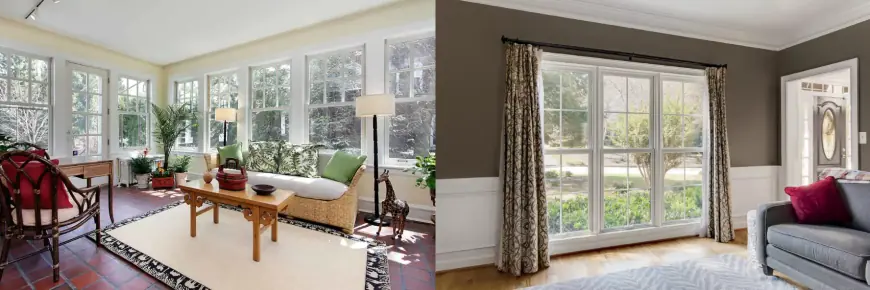What is more expensive single or double-hung windows?
Discover whether single-hung or double-hung windows are more expensive. Explore cost differences, installation expenses, and factors influencing your choice for the perfect window solution.
When choosing windows for a home renovation or new construction, one question often arises: Which is more expensive, single-hung or double-hung windows? The answer depends on various factors, including materials, installation, maintenance, and personal preferences. In this blog, we will explore the key differences, cost considerations, and other aspects that influence the price of single-hung and double-hung windows.
Understanding Single-Hung and Double-Hung Windows
Single-Hung Windows
Single-hung windows have two sashes: a fixed upper sash and a movable lower sash that slides vertically. This design makes them relatively simple in construction, which often translates to lower costs.They are often preferred in traditional homes or for homeowners looking for cost-effective solutions.
Double-Hung Windows
Double-hung windows also have two sashes, but unlike single-hung windows, both sashes are operable. This design allows for greater versatility in ventilation, as you can open both the top and bottom sashes simultaneously. Double-hung windows are a common choice for modern homes, and their enhanced functionality often comes at a premium cost.
Cost Comparison: Single-Hung vs. Double-Hung Windows
The cost of single-hung and double-hung windows depends on several factors:
-
Initial Purchase Price
- Single-Hung Windows: These windows are generally more affordable, with prices typically ranging from $100 to $400 per window, depending on size, material, and brand. Their simpler design and fewer moving parts contribute to their lower price point.
- Double-Hung Windows: Double-hung windows are more expensive, with costs ranging from $150 to $600 per window or more for premium materials. The added functionality and complexity of having two operable sashes increase the manufacturing and purchase price.
-
Installation Costs
- Single-Hung Windows: Since these windows have fewer moving parts, they are easier and faster to install. Installation costs for single-hung windows typically range from $100 to $250 per window.
- Double-Hung Windows: Double-hung windows take slightly longer to install due to their design. Installation costs may range from $150 to $300 per window.
-
Maintenance and Repairs
- Single-Hung Windows: With fewer moving parts, single-hung windows require less maintenance and are less prone to mechanical issues. This can save money on repairs and upkeep in the long run.
- Double-Hung Windows: While double-hung windows offer more functionality, their additional moving components may require more maintenance and repairs over time, potentially increasing long-term costs.
-
Energy Efficiency
- Both single-hung and double-hung windows can be energy-efficient when equipped with modern features like double-pane glass, Low-E coatings, and insulated frames. However, the cost of these upgrades is similar for both types, so energy efficiency does not significantly sway the price comparison.
Factors Influencing Price Differences
-
Material Choices
The material of the window frame—whether wood, vinyl, aluminum, or fiberglass—affects the overall cost. Vinyl is generally the most affordable option, while wood and fiberglass are more expensive. Both single-hung and double-hung windows are available in these materials, but the difference in price between the two types remains consistent across materials. -
Customization Options
Homeowners often pay more for custom sizes, colors, finishes, and hardware. Double-hung windows are often chosen for more decorative or upscale applications, leading to higher customization costs compared to single-hung windows. -
Brand and Quality
Premium window brands may offer higher-quality materials and advanced features, which increase the cost.
When to Choose Single-Hung Windows
Single-hung windows are ideal for:
- Budget-conscious homeowners: Their lower upfront cost makes them an economical choice.
- Limited ventilation needs: They are sufficient for rooms where minimal ventilation is needed.
- Traditional aesthetics: Their simpler design complements classic or traditional home styles.
When to Choose Double-Hung Windows
Double-hung windows are a better fit for:
- Enhanced functionality: They allow for better ventilation and easier cleaning, as both sashes can be tilted inward.
- Modern or versatile designs: They suit a variety of architectural styles and offer a more contemporary look.
- Ease of maintenance: The ability to tilt both sashes inward makes cleaning more convenient, especially for upper-story windows.
Conclusion
In most cases, double-hung windows are more expensive than single-hung windows due to their additional functionality and versatility. While single-hung windows are a cost-effective option for those on a tight budget, double-hung windows may be worth the investment for homeowners who prioritize ease of use, aesthetics, and ventilation flexibility.
When choosing between the two, consider not only the initial costs but also factors such as long-term maintenance, energy efficiency, and how the windows will fit with your home’s design. Consulting with a window professional can also help you make an informed decision that balances your needs and budget.
By weighing the pros and cons of each type, you can find the perfect window solution for your home, ensuring both comfort and value for years to come.

 canberrawindowsdoors
canberrawindowsdoors 











